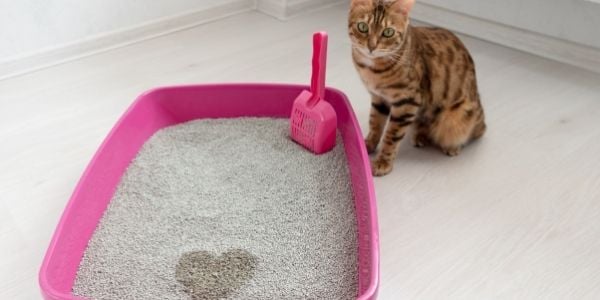
Did you know that a sample of your cat’s urine can give your veterinarian a wealth of information about their health?
This liquid gold can help them diagnose why your cat may be peeing outside the litter box, why there may be blood in their urine, or why they may be losing weight.
It also helps them monitor the progression or status of kidney disease, urinary tract infections, or diabetes. And there are even more benefits to collecting a sample for analysis and culture than those mentioned.
Whatever problem you’re bringing your cat to the vet for, or even when it’s just for a routine wellness check-up, a urine sample is always a welcomed gift by us vets.
When making your cat’s appointment, ask if they want to collect the urine sample there or if they want you to bring in a sample. The answer to this question will determine your next steps.
Regardless of how the urine sample is obtained, your veterinarian will need some help from you. Don’t worry; I've got some tricks and tips to help ensure that your vet can get the urine they need to provide you with the best information, advice, and treatment for caring for your cat.
Skip to section:
How a Urine Sample Is Collected from a Cat
The reason for needing a urine sample (routine wellness urinalysis, culture, or diagnostic urinalysis) will determine if your veterinarian will collect the urine sample themselves or if you should bring one (in some cases, it may be both!).
To get the most accurate results (for a urine analysis or a culture) is for your veterinarian to collect the urine in their clinic via cystocentesis. A cystocentesis removes urine directly from the bladder using a needle so it is fresh and without the risk of any contamination when passing through the urethra. It is safe, very quick, and relatively pain-free (similar to your cat getting any injection). Although, some cats find it a bit stressful, as they have to lie on their back or side.
Your veterinarian will thoroughly wash and sanitize their hands to avoid any contamination of the area where they'll insert the needle. They will separate your cat’s fur using alcohol and then clean and disinfect the skin over the area where the bladder is located. Then they will insert a fine, sterile needle into the bladder and remove urine via a syringe (similar to drawing blood). If your cat has a smaller or less filled bladder, your veterinarian may use an ultrasound machine to find it. The image below shows this in action.
For this process, a full bladder is best, as it will take less time to get the sample, so it's less stressful for your cat. Your veterinarian can feel if their bladder is full, so try your best to follow the steps in the next section because you'll need to prevent your cat from urinating prior to their visit.
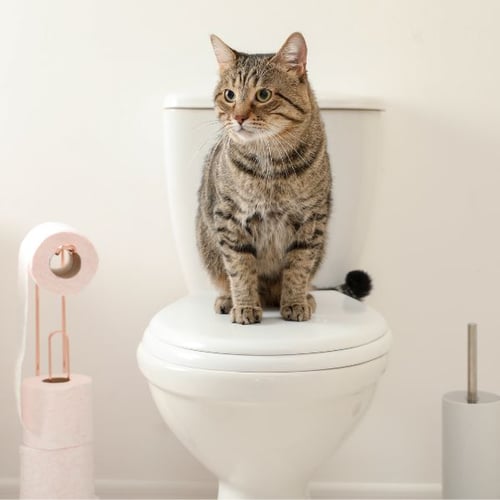
How to Keep Your Cat from Urinating Before Going to the Veterinarian
If your veterinarian needs to collect the sample of urine via cystocentesis, you will need to do your best to bring your cat in with a full bladder.
A first-morning urine sample is the most ideal sample since it is the most concentrated. But it will only be concentrated if your cat doesn't pee throughout the night, like if they sleep in bed with you, as mine used to. This helps provide better and more accurate results when tested. This may seem impossible, but you can do it!
Steps to take before going to the vet
Attempt the following steps in order to deliver your cat with a bladder full of urine.
- Vet appointment: Make your cat’s veterinary appointment for first thing in the morning – ideally as soon as they open.
-
Isolate your cat: How to keep your cat from peeing? If possible, isolate them overnight in a room (bathroom or other non-carpeted room) with their food and water but no litter box.
Note: There are a few challenges to be aware of. If your cat isn't used to being confined in a small room, they may vocalize and get pretty upset overnight. And without access to a litter box, there is a high likelihood they'll soil someplace else. If your cat does either of these things, please don't get upset. Keep in mind they've been through a stressful change in their routine. It's normal for them to vocalize as a way of asking to get out and peeing when they need to pee, whether there's a litter box available or not. If it's easier on you, isolate your cat during the day and give them some interactive toys to play with to occupy their time.
To help decrease your cat's stress and anxiety while they are confined, plug in a Feliway diffuser and provide calming treats.
If you confine your cat to a bathroom, close the tub and sink drains, put the toilet seat lid down, and cover your air vents. Some cats will pee in these spots, and you might not notice if it "goes down the drain." At least this way, you'll know if your cat peed or still has a full bladder.
Note: For cats, who can’t be confined, give them the run of the place but pick up or block off their litter boxes, sinks, tubs, and floor vents. It is important to realize if you opt for this situation, your cat may pee, and you will not know it. -
Morning routine: Most of you know your cat’s morning routine, so try to get them in their carrier before they empty their bladder.
For an outdoor cat, bring them indoors the night before your vet appointment or at least several hours prior to it.
And bring your cat "as you are!" No reason for you to get "cleaned up” for this visit. Any delay in getting ready in the morning gives your cat the opportunity to pee, even if it isn’t in a litter box.
-
Going to the vet: Transporting your cat to the veterinary clinic should be done in a carrier that, ideally, has a top-opening door or one that is easy to dismantle. This allows for removal of your cat in a less stressful manner. Ones with small front doors can make it difficult to remove your cat and cause unnecessary stress. Carriers that are too small can cause stress, so be sure you get a carrier that is an adequate size for your cat to be comfortable in. This Sleepypod one doubles as a bed your cat can use at home, making a carrier they are extra familiar and comfy in.
-
Thirty to sixty minutes prior to leaving, spray the inside of the carrier with Feliway and give your cat a calming treat – do not give your cat a treat if they tend to get care sick.
-
Do not place any towels or bedding in the carrier so that your cat doesn't choose to urinate on them during the trip or while being removed.
-
For cats who are prone to stress, you can cover the carrier with a light towel so they feel more secure.
-
Changes in your cat’s routine may cause them stress — which isn’t in anybody’s best interest. Read this article for more tips and advice on decreasing the stress you and your cat may experience with a trip to the vet.
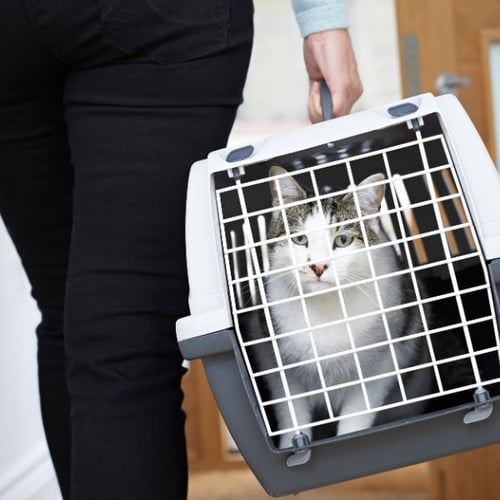
You Have Arrived at the Vet. Now What?
Depending on the time of your appointment, your veterinarian may advise you to arrive a little early so that your cat can be allowed some time to unwind in a calm and quiet room within the clinic prior to their cystocentesis.
In an ideal world, your cat didn’t urinate overnight or in their carrier, and they were calm and relaxed for their cystocentesis. But we all know nothing ever goes as planned, and sometimes we just need a backup plan(s).
Plan B
If the urine-concentrating ability of your cat’s kidneys isn’t a crucial piece of information your vet is looking for at that particular time, your vet may give your cat a dose of subcutaneous fluids (under the skin) and sit them in a cage for a few hours while those fluids work their way through your cat’s kidneys and arrive in their bladder as urine. This will require you to leave your cat at the veterinary hospital for several hours.
Plan C
For initial urine assessments and for certain diagnostic urine tests, a free-catch urine sample can be obtained. This can be done in the veterinary hospital or at home. Since many cats are experts at holding their urine while staying at the hospital, your veterinary may have you collect a urine sample at home.
It is important to realize that free-catch urine samples can impact certain test results, especially if they are not handled and stored properly. For example, unlike a cystocentesis, these samples are already mildly compromised before they ever reach the litter box because the lower aspect of the urethra and the external skin can deposit debris, cells, and bacteria. Additionally, there is always the risk of contamination from the litter box. But despite these drawbacks, it can still provide essential information and provide guidance for other necessary diagnostic tests.
Learning how to easily and properly collect your cat’s urine benefits your cat and you. And we are here to teach you how!
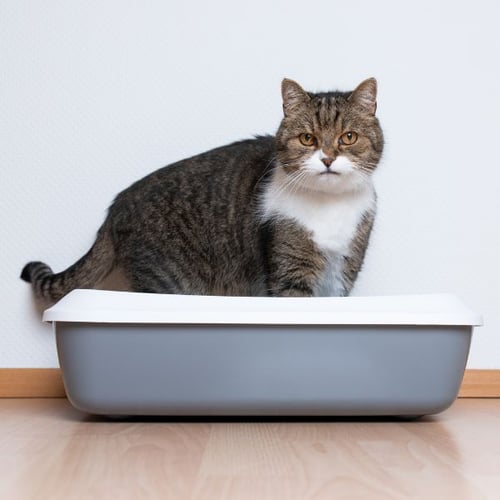
How Long Before a Vet Appointment Should You Collect the Urine Sample?
Try to get as fresh a sample as possible. Ideally, your cat's first-morning urine is the best since it is the most concentrated, as long as they didn't pee throughout the night.
Note: If you can’t bring the urine sample to your veterinarian for analysis within fifteen to thirty minutes of collecting it, you can refrigerate it for up to 4 hours. Since urine samples should not be kept more than 24 hours in the refrigerator before analysis, and many are sent off to labs, the sooner you bring it to your vet, the better. This is especially true if they are being used for cytology (studying cells).
What Happens When Cat Urine is Left at Room Temperature?
When urine is left out at room temperature, it can alter the results of testing.
Some changes that can occur include:
Appearance: The urine can become cloudy or hazy if left at room temperature for too long. Typically, fresh urine is clear unless there are substances (crystals, blood, pigment, fat) that alter the clarity. This change in clarity confuses test results.
Color: If urine sits at room temperature for more than 30 minutes, it begins to darken. These alterations in urine color can potentially alter the results of the analysis.
Smell:As urine sits, it will begin to smell due to the production of ammonia by the bacteria. When cats have urinary tract infections, fresh urine often has a foul odor.
Crystals: Crystals can form when urine is left out, and there is a delay in the analysis. If your veterinarian is unsure if the crystals are significant or related to the sample sitting out, they may require another fresh sample be collected.
Red blood cells: When urine is left out, red blood cells can swell and become hard to recognize. Eventually, they can fall apart. The presence of red blood cells is an important diagnostic indicator.
White blood cells (WBCs): The WBCs will break down and not be visible under the microscope. These cells are used to identify if there is infection or inflammation. If they break down prior to analysis, this can cause a misdiagnosis of the condition.
Bacteria: Every 20 to 40 minutes, in warm urine, bacterial counts can double. This can result in a false increase in the bacteria count, which can cause your cat to be misdiagnosed with a urinary tract infection when they may not have one.
pH: If urine is left at room temperature, it becomes alkaline, and the pH will be falsely elevated. Knowing the pH of your cat’s urine is an important part of determining what may be going on with your cat.
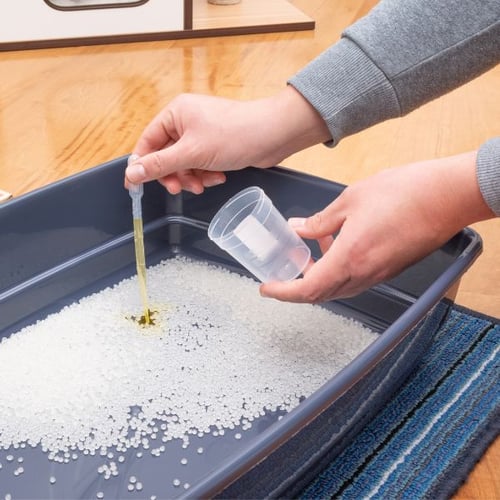
How to Collect a Urine Sample from Your Cat
Collecting your cat's urine sample at home is quite easy, but you have to follow these steps.
Step 1: Prep the Litter Box & Isolate Your Cat
Litter Box
In order to get the most accurate results, it is best to use a brand new clean litter box that you wipe out with a clean, lint-free damp cloth and let air dry.
If you use an existing litter box, you must empty it completely. Then clean it thoroughly with warm water, a mild detergent, such as an unscented dish soap, and a clean, lint-free cloth. DO NOT use harsh cleaners, such as bleach or ammonia, as they may affect the urine composition and affect test results. Be sure the litter box has completely air-dried before moving on to the next step. Do not dry it with paper towels since they may leave debris that can alter the results of the urinalysis.
It also may help to provide an additional litter box that is completely empty, as your cat may not like the new litter (step 2). The only downside of that is your cat may step in the pee after they urinate.
Isolation
If possible, place the specially prepared litter box and your cat in an isolated room, such as a bathroom. This way, you are better able to control the situation.
Cats often don't like change, so with the change in the box and litter, it's recommended to keep your cat from roaming your home and peeing somewhere else other than the prepared litter box. Be sure to close the sink and tub/shower drains, put down the toilet seat lid, and cover air vents. Since being isolated to a room may be stressful for some cats, use a plug-in Feliway diffuser as well as calming treats to help your cat relax.
It's best to isolate your cat overnight for a more concentrated urine sample if they are the type to 'hold it' all night. It provides your vet with the best sample.
Also, isolating overnight helps you know if they even peed – you can tell if it's recent pee or not – recent pee will be warm and won't be dried up around the edges. And you can feel the warmth when you draw it up in a pipette. Gross but true!
Isolating, while not always ideal, is meant to hopefully speed up the process of collecting a sample. If you wake up and your cat hasn't peed, then you can get them to the vet for them to collect a sample. And because isolating your cat at night might cause them to vocalize and disturb you and your neighbors, you can isolate them during the day.
Any sample is better than no sample. If you know your cat's routine is to urinate multiple times during the night and drink/eats frequently during the night, then any time you can try to get a sample is fine. The isolation is important so you know if your cat urinated or not -– even if it's not in the litter box. Then you know to give your cat a break and try again another time!
Step 2: Get the Right Litter
Since many (actually most) cats won’t use an empty litter box, you may need to use some type of non-absorbent litter. Non-absorbing cat litter helps you collect a stress-free urine sample.
Some options you can use include:
-
Nosorb litter – fairly inexpensive and comes with the container to bring the urine to the vet
-
PawCheck cat litter – comes with collection kit (pipette and storage container. You can wash and reuse the litter up to five times.
-
Kit4Cat hydrophonic litter – comes with 3 collection kits that allow you to easily get a diagnostic urine sample from your cat.
If you are unable to get non-absorbent litter, you can try the following options. However, these options are far from ideal, and for certain things like checking for the presence of red or white blood cells and specific gravity, it doesn't matter if the urine has some particulate matter, like a bit of dust.
Warning: Do not use any of the items below if your cat is likely to chew non-food items, especially the plastic bag, straws, and packing peanuts. You may want to leave some interactive toys with your cat when they're in isolation.
-
Popcorn kernels – typically take one to two handfuls. Rinse them well with distilled water and let them air dry to decrease possible contamination.
-
Shredded plastic shopping bags (some have animal products that coat them, so they are enticing)
-
Packing peanuts that are not biodegradable and do not melt when in contact with liquid
- Cut-up plastic drinking straws
-
Plastic beads
- Washed and dried landscaping pea gravel
Step 3: Collect the Urine
Using litter options from the lists above will allow the urine to seep through and not get absorbed by the "litter."
Collect the urine sample (ASAP) from the box using a syringe or a pipette. I do not recommend trying to pour the urine from the litter box into the transport container. This will increase the likelihood of spilling it. And we don’t want to waste a drop!
Urine should be collected within 15 to 30 minutes after your cat has peed and refrigerated if you can't transport it to your vet immediately. The longer it sits around at room temperature, the more likely it will change and affect the test results. You may want to set up a monitoring camera and check on your cat every 10 minutes.
How Much Urine Does Your Veterinarian Need?
They need a minimum of 6 ml (1.2 teaspoons) of urine for analysis and culture. But more is ALWAYS welcomed.
Transfer the collected urine to a sterile urine jar (your veterinarian may provide you with one, you can purchase one or use one that came in the kit you bought). You don’t want to use household containers since they could potentially contaminate the urine sample and alter the test results.
Step 4: Bring the Sample to Your Vet ASAP
Transport the sample, after collecting it, within 15 to 30 minutes to your vet. This helps to ensure the most reliable and accurate test results. If you are unable to transport the sample immediately, place it in the fridge. If you have far to travel, put it in a cooler (36 to 45 F). Do not keep the sample longer than 4 hours from collection, even though it is refrigerated. Samples need to be analyzed within 24 hours of collection.
 The information you share will help many other cats.
The information you share will help many other cats.
It's anonymous and will take 1–2 minutes.
Thank you!



